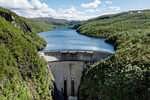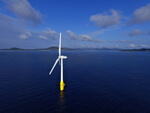News Release from American Clean Power Association (ACP)
Wind Industry Profile of
11/15/2011
AWEA - Wind power: Keeping America's lunch money at home
"Will China eat our (renewable) lunch?," the title of a recent Forbes.com blog article by Julian Chang bluntly asks. I'm pleased to report that for wind energy, the answer is no -- If we do the smart thing and allow this industry to continue to grow.
Unfortunately, we could still make the mistake of giving our lunch away, and one of the simplest ways to do so would be for Congress to increase taxes on the rapidly expanding U.S. wind power industry by letting its key tax incentive, the Production Tax Credit (PTC), expire at the end of 2012.
Congressmen Dave Reichert (R-Wash.) and Earl Blumenauer (D-Ore.) have introduced H.R. 3307, the American Renewable Energy Production Tax Credit Act, which seeks to avert that misstep and allow us to eat our own lunch and feed a growing American manufacturing sector in the process.
I've addressed this very question in a previous article commenting on one of Thomas Friedman's columns in the New York Times, so I won't belabor it here, but here is a quick recap:
'Made in America' still counts for wind power: Wind turbines rotor blades are heavy, towers are heavy, and the large components are heavy, and shipping them around the world costs a bundle. According to one major manufacturer, transportation costs make up nearly 20 percent of the installed cost of a new wind farm. In a highly competitive world, that's a big number, and most manufacturers are looking to shave those costs as much as possible. Obviously, one of the best ways to do that is to assemble the wind turbines and manufacture major components as close to the wind farm site as possible. The result? More than 10 turbine manufacturers have opened factories in the U.S. in the past five years.
For the same reason--making the manufacturing process as efficient as possible and squeezing transportation costs, as well as recognizing political realities--manufacturers are working to source as many components domestically as they can. As recently as 2005, only about 25 percent of the content of wind turbines installed in the U.S. was domestic. Today, that number is more than 60 percent, and there are more than 400 factories from coast to coast producing wind turbine components. A recent report from the nonpartisan Congressional Research Service (CRS) on the wind power industry underlines this, finding that 1) domestic content of turbines is indeed increasing, 2) turbine manufacturing creates jobs in heavy industry, and 3) "policy-induced boom-and-bust cycles" are not good for the U.S. wind industry's health.
Many jobs cannot be outsourced: A wind farm project typically creates dozens or even hundreds of construction jobs--jobs that can't be outsourced and that pay salaries to workers right here in America. The same is true for a number of other related disciplines--jobs operating and maintaining turbines, driving the trucks that carry rotor blades and towers to the construction sites, performing the engineering work, and more. You can't phone them in, and they can't be done over the Internet, so they definitely are tied to the physical locations where equipment is installed. (This is also true for the solar industry, by the way. Solar panels can be made in China, but someone has to engineer the installations and put the panels in yards and on roofs, and those jobs will all be American.)
The bottom line: For the foreseeable future, wind power will remain an industry in which the key is building a domestic market. Because of these characteristics of wind power technology, the creation of a market is that from which all else flows--if wind farms are being installed here, the turbines and the vast majority of their 8,000 parts will be built here, and the associated construction, transportation, and operations and maintenance paychecks will go to American workers and support American families.
The key to building a strong domestic market for wind? Supportive, consistent tax policy, which in turn means avoiding a significant tax increase in the near term on this emerging industry that is churning out clean energy while bringing new manufacturing jobs to an economy that desperately needs them.
For more information on this article or if you would like to know more about what www.windfair.net can offer, please do not hesitate to contact Trevor Sievert at ts@windfair.net
www.windfair.net is the largest international B2B Internet platform – ultimately designed for connecting wind energy enthusiasts and companies across the globe!
Unfortunately, we could still make the mistake of giving our lunch away, and one of the simplest ways to do so would be for Congress to increase taxes on the rapidly expanding U.S. wind power industry by letting its key tax incentive, the Production Tax Credit (PTC), expire at the end of 2012.
Congressmen Dave Reichert (R-Wash.) and Earl Blumenauer (D-Ore.) have introduced H.R. 3307, the American Renewable Energy Production Tax Credit Act, which seeks to avert that misstep and allow us to eat our own lunch and feed a growing American manufacturing sector in the process.
I've addressed this very question in a previous article commenting on one of Thomas Friedman's columns in the New York Times, so I won't belabor it here, but here is a quick recap:
'Made in America' still counts for wind power: Wind turbines rotor blades are heavy, towers are heavy, and the large components are heavy, and shipping them around the world costs a bundle. According to one major manufacturer, transportation costs make up nearly 20 percent of the installed cost of a new wind farm. In a highly competitive world, that's a big number, and most manufacturers are looking to shave those costs as much as possible. Obviously, one of the best ways to do that is to assemble the wind turbines and manufacture major components as close to the wind farm site as possible. The result? More than 10 turbine manufacturers have opened factories in the U.S. in the past five years.
For the same reason--making the manufacturing process as efficient as possible and squeezing transportation costs, as well as recognizing political realities--manufacturers are working to source as many components domestically as they can. As recently as 2005, only about 25 percent of the content of wind turbines installed in the U.S. was domestic. Today, that number is more than 60 percent, and there are more than 400 factories from coast to coast producing wind turbine components. A recent report from the nonpartisan Congressional Research Service (CRS) on the wind power industry underlines this, finding that 1) domestic content of turbines is indeed increasing, 2) turbine manufacturing creates jobs in heavy industry, and 3) "policy-induced boom-and-bust cycles" are not good for the U.S. wind industry's health.
Many jobs cannot be outsourced: A wind farm project typically creates dozens or even hundreds of construction jobs--jobs that can't be outsourced and that pay salaries to workers right here in America. The same is true for a number of other related disciplines--jobs operating and maintaining turbines, driving the trucks that carry rotor blades and towers to the construction sites, performing the engineering work, and more. You can't phone them in, and they can't be done over the Internet, so they definitely are tied to the physical locations where equipment is installed. (This is also true for the solar industry, by the way. Solar panels can be made in China, but someone has to engineer the installations and put the panels in yards and on roofs, and those jobs will all be American.)
The bottom line: For the foreseeable future, wind power will remain an industry in which the key is building a domestic market. Because of these characteristics of wind power technology, the creation of a market is that from which all else flows--if wind farms are being installed here, the turbines and the vast majority of their 8,000 parts will be built here, and the associated construction, transportation, and operations and maintenance paychecks will go to American workers and support American families.
The key to building a strong domestic market for wind? Supportive, consistent tax policy, which in turn means avoiding a significant tax increase in the near term on this emerging industry that is churning out clean energy while bringing new manufacturing jobs to an economy that desperately needs them.
For more information on this article or if you would like to know more about what www.windfair.net can offer, please do not hesitate to contact Trevor Sievert at ts@windfair.net
www.windfair.net is the largest international B2B Internet platform – ultimately designed for connecting wind energy enthusiasts and companies across the globe!
- Source:
- American Wind Energy Association
- Author:
- Posted by Trevor Sievert, Online Editorial Journalist / By Tom Gray, www.awea.org/blog/
- Email:
- windmail@awea.org
- Link:
- www.awea.org/...
- Keywords:
- awea, wind, wind energy, wind turbine, rotorblade, awea, ewea, wind power, suppliers, manufacturers, renewable energy, trevor sievert


























